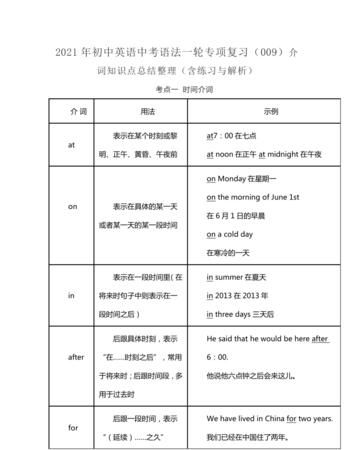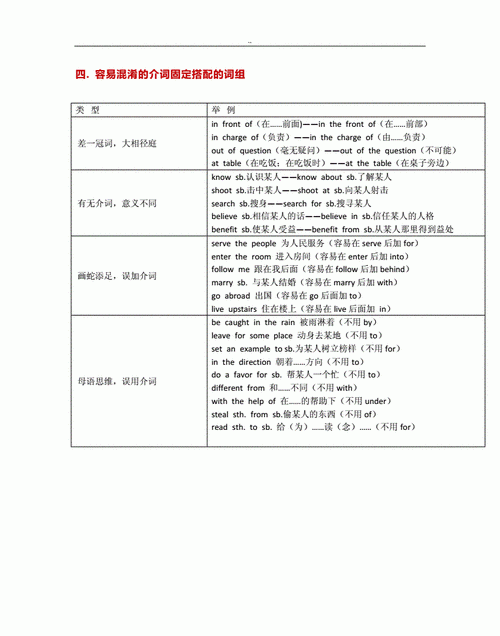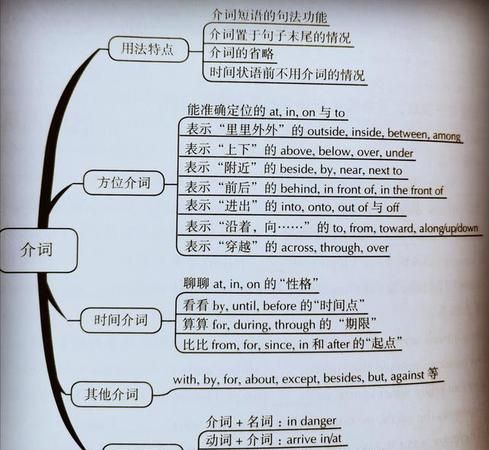本文目录
初中英语介词知识点归纳
初一学习过的介词知识比较多,所以对于所学过的介词做好总结很重要,以下是我分享给大家的初一英语介词的知识点,希望可以帮到你!
初一英语介词的知识点
一.时间介词的用法辨析1.时间介词in、on、at、by的用法辨析
A.介词in用来表示一天中某段时间,指天、年、月、季节、周次等.如:in the morning
B.介词on用来表示某一天或星期几,指明具体的时间.如:on a rainy day
C.介词at用来表示特定的时间、节日、年龄等.如:at noon
D.介词by表示…的时候、到、等到…已经等用在天、时间的前面.如:by 2 o‘clock
2.时间介词in与after 的用法辨析
A.介词in + 一段时间用于一般将来时.如:We’ll go to school in two weeks.
B.介词after + 一段时间用于一般过去时.如:My mother came home after half an hour.
C.介词after + 时间点常用于一般将来时.如:We’ll go out for a walk after supper.
3.时间介词for与since的用法辨析
A.介词for 表示一段时间如:I have been living here for 10 years.
B.介词since 表示从过去某一时间以来如:I have been living here since 2000.
4.时间介词during与for的用法辨析
A.当所指的时间起止分明时用介词during如:He swims every day during the summer.
B.如果一段时间不明确则用介词for如:I haven’t seen her for years.
5.时间介词before与by的用法辨析
A.介词before表示“在…之前”如:He won’t come back before five .
B.介词by表示“到…时为止,不迟于…”如:The work must be finished by Friday.
6.时间介词till与until用法的异同
A.till和until用在肯定句中,均可表示“直到…为止”,如:I will wait till(until)seven o'clock.
B.till和until用在否定句中,均可表示“在…以前”或“直到…才”.
如:Tom didn't come back till(until)midnight.
C.till多用于普通文体,而 until则用于多种文体,并且在句子开头时,用until而不用till.
如:Until he comes back,nothing can be done.
7.不用介词表达时间的几种情况
A.当表示时间的词前有this, that时,其前面不用介词,如:this morning
B.当表示时间的词前有next时,其前面不用介词,如:next Sunday
C.当表示时间的词前有last时,其前面不用介词,如:last Sunday
D.当表示时间的词前有one, any, each, every, some或all时,其前面不用介词,如:You can come any day.
二.方位介词与地点介词的用法辨析1.方位介词on, over, above的用法辨析
A.介词on表示一物放在另一物上面,两者紧贴在一起,如:The book is on the table.
B.介词over表示一种垂直悬空的上下关系,即“在…上方”,如:Is there any bridge over the river?
C.介词above表示一般的“高于…”,“在…之上”,如:There was an electric clock above his bed.
2.方位介词under与below的用法辨析
A.介词under是over的反义词即“在…下方”,如:They were seen under the tree.
B.介词below是above的反义词即“低于…”,“在…之下”,如:They live below us.
3.方位介词across,、through、over,、past的用法辨析
A.介词across着重于“从一头或一边到另一头或另一边”,强调从表面穿过.
如:She went across the street to make some purchases.
B.介词through着重于“穿越”,强调从一定的空间内穿过.
如:The sunlight was coming in through the window.
C.介词over多表示从“上方越过”,如:He failed to go over the mountain; he had to go round it.
D.介词past表示从“面前经过”,如:Someone has just gone past the window.
4.方位介词in、on、at的用法辨析
A.介词in表示“排、行、组”,如:We are in Team One.
B.介词on表示“左、右”,如:Li Ping is on my left.
C.介词at表示“前、后”,如:I sit at the front of the classroom.
5.方位介词to、for的用法辨析
A.介词to表示目的地或去的目的,如:Wil you take a train to Tianjian.
B.介词for表示动身去某地,如:He got on a train for Shanghai.
6.地点介词at与in的用法辨析
A.介词at表示较小的地方,如家、村、乡村等,如:He lives at a small village.
B.介词in表示较大的地方,如大城市、国家、洲等,如:He lives in Beijing.
7.地点介词at与on的用法辨析
A.介词at用于门牌号,如:He lives at No.200, Nanjing Road.
B.介词on用于路名,如:He lives on Nanjing Road.
8.地点介词in、on、to的用法辨析
A.介词in表示“包含”如:Beijing is in the north of China.
B.介词on表示“紧邻”如:Canada lies on the north of the U.S.
C.介词to表示“没接触”如:France lies to the south of England.
初一学好英语的建议
一、培育学习英语的兴致
爱因斯坦以前说过:“兴致和喜好是最好的老师。”浓厚的学习兴致,可以使人集中力气,深化深刻思考。有的同学会说:“我天然生成就对英语没兴致。”此言差矣。须知,有点兴致并非与生俱来,而是后天培育的。为何不试着经过你有兴致的物品去挨近你无兴致的英语学习呢?务必别把英语只了解成单调的单词、语法,务必别把英语学习当成一种负担。
二、要有准确的学习举止神情
1. 要勤学苦练 学英语没有近路可走,要想学好英语,达到使用自若的程度,非下苦工夫不可以。下苦工夫就是要施行数量多的听、说、读、写训练,使各项技能达到很熟练的境地。语言知识应当理解,但不下于苦功在听、说、读、写上训练,仅靠死记硬背一点孤立的单词、语法条条,是很难掌握英语的。就像学潜泳、跳意大利舞同样,对其理论掌握再好,不经过反反复复训练是永恒也学不会的。
2. 要坚持不懈
学习英语既是是训练技能夫的过程,就没可能那末轻松,要么怕艰难,坚决保持学习。学习如背水行舟,不进则退,最忌“三天打鱼,两天晒网”,要日积月累,支付长时期的尽力尽量。
三、要掌握准确的学习办法 1. 过好语音关
语音是学习英语的第1关。不掌握准确的发音,就不敢大声朗读和会话;句子不可以上口,后续的训练就难于施行。因为这个,要仔细听老师的发音和灌音带,胆量大实践,反反复复临摹,相比较匡正,不要怕出错。对中国学小时候起说,要达到发音绝对准确并非一日之功,要有信心,有耐性,就一定能够成功。
2. 注意英语和汉语的差别
英语和汉语是两种不一样的语言系统,如英语语音中的短母音、子音缀合以及摩摩擦音、破摩擦音收尾节奏等在汉语中都没有。英语有形态变动,如表名称的词复数变动、动词时态变动等,而汉语基本上没有。英语语法和句子结构同汉语也存在着一点差别。中学生的汉语习性已相当坚固,对英语学习会有一定的干扰效用,因为这个本来就要养成令人满意的习性,不要用中文注音,不要用汉语句子仿用英语句型。一朝经过数量多的阅览和训练养成用英语思惟的习性,并萌生英语语感,便会逐层减损犯“中国式英语”的不正确的机缘。
3. 掌握规律,事半功倍 固然学习英语没有近路可走,但掌握英语语言的规律,能起到事半功倍的效用。如记忆单词,利用下边几种办法可收到事半功倍的效果。
(1)由音及形法。即弄清这个单词中的字母或字母组合的发音,依据拼音开具相应的字母或字母组合。这么既可以使我们正确发音,又能较容易地记取单词拼音书写。
(2)分类法。把学过的单词按其属性分门别类串在一块儿记。如星期:Sunday, Monday, Tuesday, Wednesday, Thursday, Friday, Saturday;季候:spring, summer, autumn, winter;学科:English, Maths, Physics, History, Chinese…;颜色:red, yellow, white, black, green…。
(3)联想法。利用词与词之间大致相似之处施行相比较,或利用词与词之间的差别施行剖析辨识。这么不止能加大深度我们对新词的印象,还同时强化了旧词。
例如:
近义词:big—large, tall—high, perhaps—maybe.
近形近音词:plan—plane—plant—planet.
反义词:black—white, heavy—light, left—right, return—borrow.
词的配搭:look at, look for, look up, look after.
单词,如同万丈大厦的基石,学好单词,在英语学习过程中就迈出了一大步。固然规则众多,各种规则也有例外,但要灵活记忆,不可以死记规则,以偏概全。
初一学好英语的建议
积累词汇
如果你是学生,可以通过英语课程,让老师帮助你了解英语的基础知识和思维方式。如果你是自学者,可以通过网络视频,根据视频上的内容了解英语的基础知识等。并且需要购买一本中英的英语词典,让你在学习英语的前期掌握足够的英语词汇。
学习语法
语法是语言的“骨架”,是词形变化规则和组词成句规则的总和,也是研究词的结构、用词规则、组合词语、句子结构等一系列规律的专门科学。具有概括性、生成性、稳定性 和系统性的特点。学习语法的目的,是为了可以更好地进行听说读写等语言实践活动。也就是说,通过对语法规则规律的掌握,减少在语言实践练习中的盲目性,提高语言的准确性。学习语法可以通过课本、书籍、网络等方法加强练习。
多读、多背、多写
学好英语,还要有坚持不懈的精神,不经历背诵大量文章,写大量东西,听大量文章(读报、听广播、看外语电影、听外语讲座、读书籍)是根本不可能达到目的的,因为学习语言需要对我们的各种感观进行刺激,每天至少看 60-120分钟的英语,早晨和晚上是学英语的最好时间。
勇于交流
前面3点可以让你很好的读和写了,但是只会读和写对于学习一门语言来说是远远不够的,我们还要学会怎样与人交流。敢于开口说英语,不要怕犯错误,人人都会犯错,这是在所难免的,加强交际训练,为自己提供一个英语环境,只有多交流,才能把口语说的很流利。
猜你喜欢:
1. 英语重点学习知识点总结
2. 中考英语知识点梳理
3. 人教版英语七年级上册知识点复习
4. 中考英语介词语法知识点
5. 初一英语知识点总结

初中英语时间介词的用法归纳
介词是一种用来表示词与词, 或者词与句之间的关系的词,在句中不能单独作句成分。初中英语介词的用法很多,为此,以下是我分享给大家的初中英语介词的用法归纳,希望可以帮到你!
初中英语介词的用法归纳
表示方位的介词:in,to, on
1. in 表示在某地范围之内。
如:
Shanghai is/lies in the east of China.
上海在中国的东部。
2. to 表示在某地范围之外。
如:
Japan is/lies to the east of China.
日本位于中国的东面。
3. on 表示与某地相邻或接壤。
如:
Mongolia is/lies on the north of China.
蒙古国位于中国北边。
2表示计量的介词:at, for, by
1. at表示“以……速度”“以……价格”。
如:
It flies at about 900 kilometers a hour.
它以每小时900公里的速度飞行。
I sold my car at a high price.
我以高价出售了我的汽车。
2. for表示“用……交换,以……为代价”。
如:
He sold his car for 500 dollars.
他以五百元把车卖了。
注意:at表示单价(price) ,for表示总钱数。
3. by表示“以……计”,后跟度量单位。
如:
They paid him by the month.
他们按月给他计酬。
Here eggs are sold by weight.
在这里鸡蛋是按重量卖的。
3表示材料的介词:of, from, in
1. of成品仍可看出原料。
如:
This box is made of paper.
这个盒子是纸做的。
2. from成品已看不出原料。
如:
Wine is made from grapes.
葡萄酒是葡萄酿成的。
3. in表示用某种材料或语言。
如:
Please fill in the form in pencil first.
请先用铅笔填写这个表格。
They talk in English.
他们用英语交谈。
注意:in指用材料,不用冠词;而with指用工具,要用冠词。
请比较: draw in pencil 与draw with a pencil.
4表示工具或手段的介词:by, with, on
1. by用某种方式,多用于交通。
如:
by bus 乘公共汽车
by e-mail. 通过电子邮件
注意:
表示搭乘交通工具时,用by时不用冠词,用in时要用冠词。
请比较:
I went there by bus/in a bus.
我是坐公共汽车去的那儿。
2. with表示“用某种工具”。
如:
He broke the window with a stone.
他用石头把玻璃砸坏了。
注意:
with表示用某种工具时,必须用冠词或物主代词。
3. on表示“以……方式”,多用于固定词组。
如:
They talked on the telephone.
他们通过电话进行交谈。
She learns English on the radio/on TV.
她通过收音机/电视学英语。
5表示关于的介词:of , about,on
1. of仅是提到或谈到过某人或某事。
如:
He spoke of the film the other day.
他前几天提到了这部影片。
He thought about this matter yesterday.
他昨天考虑了这件事。
2. about指“关于”某人或某事物的较详细的情况。
如:
Can you tell me something about yourself?
你能告诉我一些关于你自己的事情吗?
3. on指“关于”学术性的或严肃的事。
如:
It’s a textbook on the history of china.
它是一本有关中国历史的教科书。
6表原因或理由的介词:for, at,from,of, with, by,because of
1. for表示原因,常与sorry, famous, punish, praise, thank, blame等词连用。
如:
I am sorry for what I said to you.
我后悔不该对你讲那些话。
2. at指情感变化的原因,意为“因听到或看到而……”。
如:
He was surprised at the news.
听到这消息他大吃一惊。
3. from指“外在的原因”,如受伤、车祸等。
如:
He died from the wound.
他因受伤而致死。
4. of指“内在的原因”,如病、饿等。
如:
The old man died of hunger.
老人死于饥饿。
5. with指生理上或情感上的由外界到内心的原因。
如:
Hearing the news, he jumped with joy.
他们听到这个消息,欣喜若狂。
He was shaking with anger.
他气得浑身发抖。
6. by表示外部的,尤其是暴力的或无意中造成某种结果的原因。
如:
Her body was bent by age.
他因年老背弯了。
She took your umbrella by mistake.
我因弄错拿了你的雨伞。
7. because of 表示引起结果的直接原因。
如:
He retired last month because of illness/because he ill.
他上个月因病退休了!
8. owing to多表示引起某不良后果的原因。
如:
Owing to the rain they could not come.
由于下雨他们没来。
9. thanks to表示引起某种幸运结果的原因,常译为“幸亏……,多亏……”。
如:
Thanks to John, we won the game.
多亏约翰,我们才赢了这场比赛。
10. out of表示动机的起因,常译为“出于……”。
如:
He asked the question out of curiosity.
他出于好奇才问了那个问题。
11. through多表示因局部而影响全局的原因。
如:
The war was lost through bad organization.
战争因组织不周而失败了。
初中英语必考介词词组
1. 在…的前面
in front of (范围外的前面)
in the front of (在范围内的前面)
There is a river ________ my house.
我家前面有一条河。
There is a blackboard ___ our classroom .
教室前面有一块黑板。
2.在树上
on the tree 强调树上长出的东西 (苹果,橘子)
in the tree 外来物体(人,鸟,风筝)
There are some birds _____ the tree.
树上有一些鸟。
There are some apples _______ the tree.
树上有一些苹果。
3.时间表达:
in + 某月 / 某季节 / 某年 (时间长)
on + 某天 (中)
at + 具体几点几分 (短)
固定短语: in the morning / afternoon / evening
at night, at noon
练习: __January , __ summer, ___ 2014
______ Sunday, ___ March 4th, ___ March
___ _ Sunday morning,_____ the morning
_______ the morning of June 5th
_______ 6:30, ____ night, __ noon
4.在墙上
on the wall
在墙壁表面 (相片photo,图画picture)
in the wall
在墙壁的里面 (门door, 窗户window )
(1)There is a photo of my family
_______ the wall.
(2)There are two doors ______ the wall.
5. 在…之上
on: 在…的表面之上(物体之间有接触)
over: 在…的正上方(物体没有接触)
above 高于......;
在......之上”,多指在相对较高位置
(1)There is a book ______ the desk.
书桌上有一本书。
(2)There is a bridge ______ the river.
河上有一座桥。
(3)The plane flies ______the clouds(云).
飞机在云层上飞行。
6.地点表达法
(1)in 后接较大的地方
如: in Beijing, in China.
(2)at 后接较小的地方
如: at the railway station, at the bus stop
(3)on 常用于一些习惯用语
on a farm 在农场 on the earth 在地球上
on earth 究竟
at home, at school, at the back of ,
at the back of the classroom
At the end of the street,
at the second crossing
过关练习
1.There is a bank ____ the school and
there is a big desk _____the classroom.
A. in front of , in the front of
B. in the front of, in front of
2. There are some pictures _____ the wall and ______ two windows _____ the wall.
A. in, on B. on, in
3. I can see some birds ______ the tree. Look ,there are some apples ____ the apple tree.
A. on, in B. in , on
4. ---When were you born?
--- I was born _____ April.
A. in B. on C. At
5. Tom was born ______ April 5th.
A. in B. on C. At
6. I usually get up _____10 :00 ____ Sunday.
A. at, in B. at, on C. in, on
7. I arrived (到达) ___ Beijing
yesterday(昨天).
A. on B. in C. at
8.she arrived ____the railway station
just now(刚才).
A. on B. in C. at
9.There is a computer ____ the desk.
A. above B. on C. over
10.There is a bridge _____ the river(河).
A. above B. on C. over
本节回顾
1. 在…的前面
in front of (范围外的前面)
in the front of (在范围内的前面)
2.在树上
on the tree 强调树上长出的东西 (苹果,橘子)
in the tree 外来物体(人,鸟,风筝)
3.时间表达:
in + 某月 / 某季节 / 某年 (时间长)
on + 某天 (中)
at + 具体几点几分 (短)
4.在墙上
on the wall
在墙壁表面 (相片photo,图画picture)
in the wall
在墙壁的里面 (门door, 窗户window )
5. 在…之上
on: 在…的表面之上(物体之间有接触)
over: 在…的正上方(物体没有接触)
above 高于......;在......之上”,
多指在相对较高位置
6.地点表达法
(1)In 后接较大的地方
如: in Beijing, in China.
(2)at 后接较小的地方
如: at the railway station, at the bus stop
(3)on 常用于一些习惯用语
最常见的介词错误用法
1) arrive at 还是 arrive in
*When we arrived to Claudio’s house…
at通常用在具体的地点前:school学校、restaurant餐厅、airport机场、aunt’s house阿姨的家;而in通常用在城市或国家前面。
✓ When we arrived at Claudio’s house…
我们到达克劳迪奥的家……
✓ The train arrived at Shibuya station thirty seconds late.
火车延迟30秒到达涩谷车站。
✓ On Friday, the president arrived in Poland.
总统于周五到达波兰。
✓ The K-pop band arrived in Phnom Penh last week.
韩国流行乐队上周到达金边。
2) at night
*We often go out in the night.
in可以用在in the morning, in the afternoon, 和in the evening里,但是night前面需要用at。
✓ We often go out at night.
我们经常在夜晚出门。
✓ Krakow is beautiful at night.
夜晚的克拉科夫很美。
3) look for 还是 wait for
*I was looking my glasses.
*Giulia was waiting me at the bus stop.
如果你想表达寻找,那么用look for或者search for;如果你想表达等待,那么用wait for。
✓ I was looking for my glasses.
我在寻找我的眼镜。
✓ Tomis looking for a new job.
汤姆正在寻找一份新工作。
✓Giulia was waiting for me at the bus stop.
茱莉亚正在车站等着我。
✓Lucy is waiting for her sister to finish class.
露西正在等她的妹妹放学。
4) for [period of time]
*I’ve been working here since five years
for用在一段时间前面,比如:a few minutes/three months/twenty years。
since和具体的时间点连用,比如:this morning/September/the day we met。
✓I’ve been working here for five years.
我已经在这里工作五年了。
✓She hasn’t drunk coffee for years.
她好多年不喝咖啡了。
✓She’s been living in Yokohama since February.
她从二月起一直住在横滨。
✓I haven’t seen her since yesterday morning.
昨天早上之后,我就没再见到她。
5) in [months and years]
*It’s my birthday on July!
in总是和年份或月份连用。
✓It’s my birthday in July!
我的生日在7月。
✓Ola was born in 2004.
欧拉出生在2004年。
6) live/work/study in [cities and countries]
*I live at Tokyo.
在某个城市或国家居住、工作或学习用in,但住在某个具体的地址则用at,比如在一个特定的机构工作,或者是在某所大学学习。
✓I live in Tokyo.
我住在东京。
✓Roberta works in Sassari.
罗伯塔在萨萨里工作。
✓Hector studies in Canada.
赫克托尔在加拿大学习。
✓Ania lives at No.34, Green Street.
艾尼雅住在格林大街34号。
✓Ryosuke works for Toyota.
凉介在丰田工作。
✓Dara studies at Phnom Penh International University.
达拉在金边国际大学读书。
7) on [days and dates]
*It’s my birthday in Saturday!
on和具体的星期几或日期连用:
✓It’s my birthday on Saturday!
我的生日在周六!
✓It’s my birthday on May 1st. (But remember: It’s my birthday in May.)我的生日在五月一号。(但是要记住:我的生日在五月用 in。)
8) it depends on
*It depends of what you want: Italian food or Chinese food.
depend后面如果要加某人或某物,一定要和on连用,不然只能说it depends。
✓It depends on what you want: Italian food or Chinese food.
这取决于你想吃什么:意大利菜还是中国菜。
✓We’ll go to either Disney World or the beach, depending on the weather.
我们要去迪士尼乐园或海滩,这要看天气。
✓What do you usually have for breakfast – tea or coffee? – It depends!
你早餐通常喝什么——茶还是咖啡?—看情况。
9) welcome to
*Welcome in Peru!
欢迎到某地用welcome to+地点,比如:a house/school/organization/city/country。
✓Welcome to Peru!
欢迎来秘鲁!
✓Welcome to Cagliari.
欢迎来卡利亚里。
✓Welcome to Meiji University.
欢迎来明治大学。
✓Welcome to the Plaza Hotel. We hope you enjoy your stay.
欢迎来广场饭店,我们希望你在此过得愉快。
10) married to
*He’s married with Kim.
与某人结婚要用married to或者get married to,也可以说marry sb.。
✓He’s married to Kim.
他和金结婚了。
✓John’s getting married to Sara next summer.
约翰明年夏天要和萨拉结婚。
✓Kate is marrying my old school friend.
凯特要和我的一个老校友结婚了。
猜你喜欢:
1. 初中英语八种时态归纳复习要点
2. 英语比较级和最高级的用法归纳
3. 初中英语常用介词短语
4. 初中英语备考知识点:时间介词
5. 初一英语介词的知识点归纳

中考英语介词考点归纳
I. 介词的.概念
介词是一种用来表示词与词, 词与句之间的关系的词。在句中不能单独作句子成分。介词后面一般有名词代词或相当于名词的其他词类,短语或从句作它的宾语。介词和它的宾语构成介词词组,在句中作状语,表语,补语或介词宾语。
II. 牢记口诀
介词口诀:自从以当为按照,由于对于为了到;和跟把比在关于,除了同对向往朝;用在名词代词前,修饰动形要记牢。
III. 介词归类大全
(1)at ,in, on, to
at (1)表示在小地方; (2)表示在附近,旁边
in (1)表示在大地方; (2)表示在范围之内。
on 表示毗邻,接壤
to 表示在范围外,不强调是否接壤
例句:He arrived at the station at ten.
He is sitting at the desk.
He arrived in Shanghai yesterday.
Jiangsu lies in the east of China.
Russia lies on the north of China.
Fujian is to the south of Jiangsu Province.
(2)above, over, on 在上
above 指在上方,不强调是否垂直,与 below相对;
over指垂直的上方,与under相对,但over与物体有一定的空间,不直接接触。
on表示某物体上面并与之接触。

初中英语介词用法最全总结
介词在初中英语考试中是必考知识点,不少同学对介词的分类、用法都非常的模糊不知道那种情况用什么样的介词,下面为大家整理出来介词的具体分类和用法大全,帮助大家提升对介词的认识。
初中英语介词用法大全,介词用法归纳汇总
介词的定义
介词是一种虚词,不能独立充当 句子 成分,需与动词、形容词和名词搭配,才能在句子中充当成分。
介词是用于名词或代词之前,表示词与词之间关系的词类,介词常与动词、形容词和名词搭配表示不同意义。
介词 短语 中介词后接名词、代词或可以替代名词的词(如:动名词v-ing).介词后的代词永远为宾格形式。
介词的分类
一、表示时间的介词
(一)表示时间段的介词
(1)in , after
in +时间段,表示从现在起往后推算一段时间
after +时间段,表示过去某时间往后推算一段时间,如:
He’ll come back in two days. 但点钟用after( after three o’clock)
He left on July 2 and returned after three days.
(2)in , during
表示在一段特指的时间内,可用in 或during
The work was done in / during the holidays.
表示年份、月份、季节用in , 如:in 1999 ,in June , in winter
(3)in last, for the past + 时间段, during
表示在最近一段时间内,句中谓语动词常用现在完成时
I have been in Shanghai in the last few years.
(4)for 表示延续一段时间。
I’ll study in the U.S for two years
I’ve waited for Bingo for half an hour.
(二)表示某一时间的介词
(1)at, on
at 表示某一时刻,on 表示某一天或日期, 如:
at 7:14, on Saturday morning on the night of May2
一天内各段时间表达, 选用正确的介词,请比较:
in the morning
on a winter / snow / cold / morning
at night
on the night of March 7th
in the evening
on Friday evening
(2)before, by
before 表示某一时间之前,而by 表示到某一时间止,句中谓语动词多用完成时态。如::You must get up before six. 你必须六点之前起床。
By the end of last month the boy had got 4 “As”.
到上月底这个男孩已得了4个A.
(3)after , since
after 可以表示过去某一点时间之后,并不延续说话时间,和一般过去连用,而since表示从过去某时间开始的一段时间延续到说话时间, 与现在完时连用 如;
My father lived in Shanghai after liberation .
解放后我父亲住在上海.
Since the end of last year the lady has given five concerts.
自去年年底以来,这位女士开了五十场音乐会
(4)from…to, until / till
from----to表示从某一点时间到另一点时间的一段时间,而until till 表示某动作或状态延续到某点时间如:
My mother studied in Beijing University from 1960 to 1964.
从1960年到1964年我妈妈在北京大学学习。
My mother entered Beijing University in 1960, and studied there until 1964.
我妈妈1960年进入北京大学,一直学习到1964年。(但“从早到晚”常表达为from morning till night)
(三)不用介词表示时间的词或词组
含this, that, last, next 的表示时间的名词词组,以及某些时间的副词或名词词组前不用介词,如:this year last summer, yesterday , the day after tomorrow 等。
二、表示事物之间位置的介词
(1)at, in
当事物被视作一点,不强调其空间常用介词at, 而表示空间内部用介词in, 如:
We’ll meet at the supermarket 我们在超市见面
I had to stay in the supermarket as it was raining hard
因为下大雨,我只好呆在超市里
动词arrive 后接at ,表示较小的地方, 如: 车站、村庄等.后接in 表示较大地方,如: 城市,地区等
(2)in, to
in 表示事物在区域范围内的位置,to 表示事物对区域范围之外另一事物的位置,如:
Shanghai is in the east of China. 上海在中国东部
Japan lies to the east of China. 日本位于中国东面。
in front of 表示在前面,一般不在范围内,in the front of 表示在前面.在同一范围内。
(3)after, behind
after 指顺序先后 ,behind 指位置在某事物之后,相对于in front of 而言, 如:
He entered the classroom after the teacher
He hid himself behind the door 他在门后。
(4)on , in
on 表示“在某事物表面上”。如将事物看作空间,表示在其内部,用介词in。
There is a modern painting on the wall .
There is a modern painting on the wall .
(5)from , off 都表示“离开”
(6)above , over, below , under
over , under 表示垂直的上下关系,而above, below 仅表示位置上“高于”或“低于”, 不表示垂直关系。
(7)between, among
between 表示“两个事物之间”, among 表示“三者以上的事物之间”。
三、表示运动方向的介词
(1)into, inside , in 从外到内 如:
He went quickly into / inside the room.
He went quickly into / inside the room.
(2)out of 从里到外,相当于outside, 或从里向外,相当于from
She went out of from the office in a hurry 她匆匆走出办公室.
The boy watched the buses, cars and bikes out from the window .
这男孩透过窗观看外面的公交车、小汽车和自行车。
(3)on 在……表面,onto 到……上
A boat is on the river. 一条小船在河上。
He jumped onto a tree. 他跳上一棵树
(4)across 穿过一平面、through 穿过一空间
The boy kicked the ball hard and it moved across the grass.
这男孩用力踢球,球飞过草地。
The train moved fast through the tunnel. 火车飞驶隧道。
(5)The train moved fast through the tunnel. 火车飞驶隧道。
She walked to the bank 她步行到银行去
She swam towards the shore 她朝岸边游去。
四、常用介词用法比较
(1)as , like
as 表示“作为”强调身份,like (介词)表示“像”
As a teacher, he cares for these children.
Like a teacher, he cares for these children.
(2)with , in
with 表示“外貌特征或附带的东西” ,“ 用……作工具”
in 表示”衣着” ”用某语言”, 在固定搭配中也可用in
A man with dark glasses wanted to buy drinks.
A man in black wanted to buy drinks.
The boy is learning to write in pencil / with a pencil.
He retold the text in English.
(3)for , to
for表示“为了.”
To 表示动作对象, “对, 向.” 如:
He would do anything for his motherland.
Did you mention this to my father?
你对我父亲提起过这件事吗?
for 表示“就某情况而说 ”, to 表示一“对某对象而言”如:
It’s quite warm today for February.就二月的天气,今天够暖和的。
What he told you just now was not new to me
他刚才对你所说的话对我并不新鲜
for 表示“目的,用途”。与go, come动词连用,
(4)except , besides
except 表示“从总体中排除一部分”, 与bat 同义, besides 表示“除了一部分还有另一部分”
We all failed except him. 我们都失败了,但他没有。
He speaks German besides French.他懂法外还会讲英语。
(5)注意成对介词的用法:
get into (out of ) the car, get on (off) the bus, jump onto (off) the platform, out of
(6)介词和名词动词等有不少固定搭配和习惯用法:
to one’s surprise / joy, in charge of , instead of, in bed (hospital), in trouble, in a hurry, in surprise, with a smile, with one voice, according to, at once, on time, in time, in all, at home, (school, work), at last, at least, in the end, by the way, for example, at the same time, at the same speed, on one’s way (to), in the sun, on the football team, in line, with the help of, in red / green … put on, look for, look after, run after, send for, enter for, pay for, show…around, listen to, arrive in / at, get to, agree with, succeed in, think of (about), wait for,….
(7)表示加减乘除,分别用介词plus, minus, times 和动词过去分词divided + by
复习时需要注意的要点
(1) 介词一般放在名词之前,但它后面的介词宾语是疑问代词、疑问副词或者关系代词时,这些词提到了前面而只剩下介词在后了。
(2) 介词和动词、形容词、名词等常常构成固定搭配,也就是说,在这些词的后面常常要求用一定的介词。这一点在学习时要特别注意。如:
a.动词+介词:laugh at, wait for
b.形容词、过去分词+介词:be good at, be prond of
c. 名词+介词:pay a visit to , the key to
介词的实战演练
例1 We will play football three o’clock.
A. In B. After
C. To D. since
答案: B
提示: 这四个选项的介词都可以表示时间,但含义和用法不同。in常用来表示以现在为起点的将来一段时间之后,after?可表示从过去为起点的一段时间之后,通常与过去时连用。但要注意after?也可以表示将来某一特定时刻之后。本题里after表示将来某一特定时刻。
例2 The story took place a cold night.
A. in B. after
C. to D. since
答案: B
提示: on通常指特定时期:或表示某一天的上午,下午,晚上等。句中的时间状语a cold night已表明在某个寒冷的夜晚,其前面应使用介词on。
例3 We will play football three o’clock.
A. In B. After
C. To D. since
答案: B
提示: 这四个选项的介词都可以表示时间,但含义和用法不同。in常用来表示以现在为起点的将来一段时间之后,after?可表示从过去为起点的一段时间之后,通常与过去时连用。但要注意after?也可以表示将来某一特定时刻之后。本题里after表示将来某一特定时刻。
例4 The story took place a cold night.
A. in B. after
C. to D. since
答案: B
提示: on通常指特定时期:或表示某一天的上午,下午,晚上等。句中的时间状语a cold night已表明在某个寒冷的夜晚,其前面应使用介词on。
例5 This is the bus the People’s Park.
A. at B. for
C. to D. towards
答案: B
提示: 四个选项的介词表达的意义不同。at表示“在某处,在……旁边”,for表示“(动身)去……处”,to表示“到……某处”,towards表示“向……某处”。
例6 —Are your parents workers?
—No, is a worker.
A. neither B. none
C. either D. both
答案: A
提示: neither是对两个人或事物的否定,谓语用单数形式;而both则是对两个人或事物的肯定,谓语用复数形式。
例7 The work cost us more than five weeks.(保持原意)
more than five weeks the work.
答案: We spent, on
提示: cost表示花费时间,只能用表示事物的词作主语,而spend也表示花费时句子主语必须是人。注意spend…on,表示在某事上花费。
例8 Beijing has a lot of old buildings. It also has a lot of new ones.(合并一句)
答案: Beijing has not only a lot of old buildings but also a lot of new ones
提示: 这道题主要掌握表示递进关系的连词词组。
例9 My brother likes skating.I like swimming.(合并一句)
答案: My brother likes skating but I like swimming.
提示: 这道题的两个句子主语不是同一个人,谓语动词之后的部分也不同,实际上是把喜欢的内容由一个方面转到另一个方面,所以用but把两个句子连接起来。
例10 He is too young to join the army.(改复合句)
答案: He is so young that he can’t join the army.
提示: so...that表示否定时可与too…to转换。
例11 There is a hole the wall.
A. in B. on
C. of D. with
答案: A
提示: 在墙的里面,用in the wall,而on the wall指在墙的表面上。
例12 English names are different Chinese names.
A. between B. of
C. from D. about
答案: C
提示: be different from表示“与……不同”,是一个固定词组。
例13 We always have a class meeting Monday afternoon.
A. at B. on
C. in D. of
答案: B
提示: 在某天的上午下午或晚上,介词应使用0n。
例14 Please write it ink
A. with B. in
C. by D. of
答案: B
提示: 如果表示用墨水写该用in,不能用with。
例15 I’ll return the book to the library I finish reading it
A. when B. if
C. as soon as D. as
答案: C
提示: 此句意思为我一看完这本书就还给图书馆,as 。
初中英语介词用法大全相关 文章 :
1. 初一英语语法用法复习大全
2. 初中英语语法总结之介词解析
3. 初中英语介词语法知识点讲解练习
4. 英语各种介词的用法一览
5. 初中英语语法专题介词与常见短语
6. 初中英语介词知识点:时间介词
7. 初中英语语法介词
8. 英语介词in重要用法归纳
9. 初一英语必备知识要点大全

以上就是关于英语介词知识点总结,初中英语介词知识点归纳的全部内容,以及英语介词知识点总结 的相关内容,希望能够帮到您。
